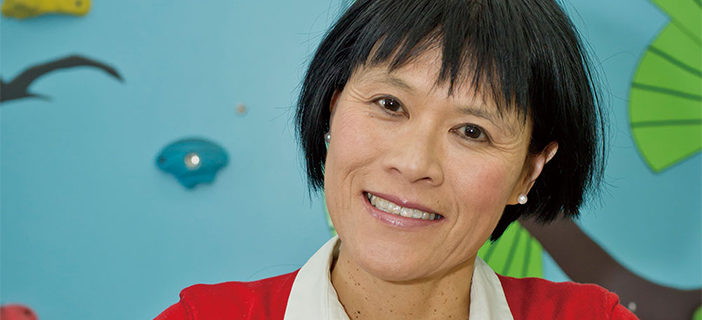Our recent post about a Beijing mom’s search for the therapy needed by her young son who has been diagnosed with Autistic Spectrum Disorder (ASD) provoked much discussion. Among those who contacted us was Eva Ma, a professional working in the field who wanted to emphasize that Applied Behavior Analysis (ABA) is not the only therapy suitable for children with ASD. We asked her to tell us more.
Can you tell us about your background and training?
EM: I am an Occupational Therapist (OT). I was born and raised in Hong Kong, but I went to the US for my college education, and stayed on there for 26 years. I came to Beijing in August 2015 and worked as an OT at Olivia’s Place, and I’ve just moved to Hangzhou.
What sort of therapeutic approaches do you recommend for children with ASD?
EM: You need to look at the whole person, not just one aspect of their limitations. In the West you might have a physical therapist, a speech therapist, and an occupational therapist, and they may be doing the same or similar tasks but looking at different things. For example if the child is playing with a ball, a physical therapist might be looking at their balance, a speech therapist will be listening for whether they can ask for a bigger or smaller ball, and an OT might be looking at how they respond to their environment, such as whether they can follow directions when it’s noisy.
We use a play-based approach, typically driven by intrinsic values. We like to develop children’s internal drive, to have an idea for play, and executing that idea, adjusting according to their thoughts or feelings. We like to work in a natural environment, in a home or school setting. It’s about consistency, about learning steps and practicing them until the child feels confident, and able to go on to the next challenge level.
What’s your view of ABA?
EM: It’s one of the methods used, but it’s not the only one. It’s a very linear approach: the child does a task and they get a reward. Often food is used with younger children. But it can be too restrictive, it’s training a child in one moment of time to do certain things. Children with autism may not able to generalize that information. It may look like they can answer the question, but in real life they are not able to use the information effectively, functionally. So they may be able to count to 20, but if I say “go down the corridor to room number 12 and get a book,” are they able to scan the numbers, identify “1 2” as twelve, identify the book and bring it out?…
But you can understand that a parent who has seen their child make progress after a period of frustration will take a more positive view of ABA?
EM: In the US there’s a lot of research on ABA, and they’re able to “prove” it works by picking data every time the child gets something right. Based on those papers insurance companies say “ABA works.” For parents relying on just insurance, of course they’ll go for something that’s covered. One hour of occupational therapy can cost USD 100, so if you have to copay for 20 hours… you wouldn’t pick OT! We use a play-based approach, which is more difficult to measure. We do have a few studies showing it works, but we don’t go around advertising ourselves very well! And we prefer to work in a natural setting, in the home or school. But if support is provided in school insurers can say it’s education-related and refuse to cover it. Therapy has to take place in a medical center or clinic, which means taking the child out of school, dealing with travel and traffic…
How do you see provision of services for children with special needs in China?
EM: People think China is rich now, but medical care is so behind in the human aspect. Money can buy the latest technology like MRI scanners, but the hardest part is human resources. There’s a gap for a therapeutic approach. Expats often come thinking there should be services, but if you have a child with any kind of disability you can be quite isolated. Many schools are struggling to accept students with even mild learning difficulties or autism, because there’s not enough support. Sometimes schools have to be honest, and have to ask the child to leave the class or leave the school. I know some parents who just couldn’t do it, and had to go back to the west.
The stigma of having a disability is still so strong. If you go to a middle class Chinese school there usually isn’t any special education or therapy. And autism is not a visible disability, so people think the child is dumb or naughty. A lot of Chinese parents will still reject the idea that child needs extra help. They’ve put all their hopes and dreams on one child, and they’re not prepared to feel their child is not perfect. Their journey is becoming aware, appreciating their child for who they are, and accepting help.
What needs to be done to put more services in place?
EM: It will be slow, because culturally it’s not comfortable. People want to be the same, blend in. We need advocacy, more parents asking for help like the mom in your story. I hope all this will evolve. Younger Chinese people going overseas to university might come out as good special needs teachers or good therapists, and be ready to come back to China to work.
Another aspect is that a couple of schools are strengthening their learning support programs so they can accept children with special needs. The International School of Beijing (ISB) and Western Academy of Beijing (WAB) are both looking into their own programs. We need more inclusive education, instead of the idea of special schools for special children. Inclusion has benefits for both types of children.
I’m hopeful, but it’s still very challenging. My prediction is it will happen, but very slowly.
Photo: Uni You





1 Comment
Hi,
I have a lot of issues about Eva Ma’s response on ABA due to her lack of research and lackluster understanding of the field. She is providing an oversimplification of what ABA entails. Her responses and this article will turn parents away from even attempting to reach out for services that can very well be beneficial to their children. I would like to set up an opportunity to chat with her.